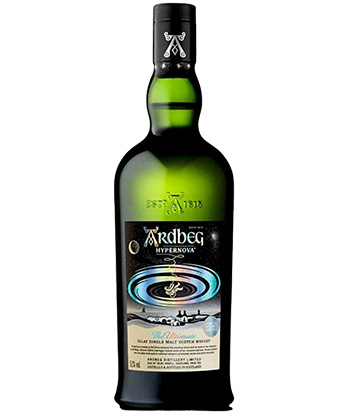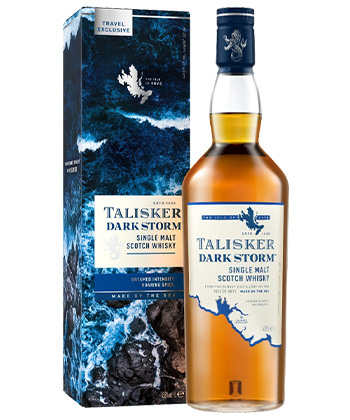Known for its distinct smoky, borderline medicinal essence, peat is an integral part of the Scotch production process. And love it or hate it, this accumulation of plant and organic matter is an integral part of the whisky production process. According to the Scottish government, approximately 80 percent of all whisky in the country is made with the stuff, which releases compounds called phenols when burned during the malting process. These phenols, measured in parts per million (ppm), are what imbue the liquid with its signature earthy, charred notes once distilled.
Generally speaking, the higher the ppm, the smokier the whisky. However, the measurement is not the sole adjudicator of how peated a whisky might taste. Instead, it reflects the number of phenol parts in the malted barley used during distillation, not necessarily how much is in the spirit itself. The amount of phenols in the liquid can often be much less than what is measured in the barley, and the smoke’s influence can be tapered down during the maturation process.
That said, most heavily peated Scotches — “peat bombs” as they are often called — will fall between 35 and 55 ppm and offer notes like campfire, tar, leather, and vegetation. Some distilleries, like Bruichladdich and Ardbeg, are pushing things even further by releasing expressions with triple-digit ppm for peat fanatics. Bruichladdich Octomore 8.3, for example, is the peatiest whisky ever made in Scotland at a whopping 309 ppm.
Given the popularity of peated whiskies, we compiled a list of some of the biggest peat bombs to hit the market in recent years. Considering Bruichladdich’s and Ardbeg’s shared willingness to experiment with high levels of phenolic compounds, many of the peatiest Scotches come from the two distilleries. As such, we only included the top two most heavily peated expressions from each brand.
Looking for a new peat bomb? Check out some of the world’s most heavily peated Scotches below.
Bruichladdich Octomore 8.3
 First released in 2008, Bruichladdich’s annual Octomore series features some of the most heavily peated Scotches in the world, with levels consistently exceeding 100 ppm. The brand releases three or four distinct expressions each year, each showcasing not just the influence of peat smoke on the liquid, but different aging techniques. The 2017 collection, Octomore 8, included the most heavily peated Scotch ever made: Octomore 8.3. Aged in a combination of first-fill bourbon, ex-Paulliac, Ventoux, Rhône, and Burgundy casks, the limited-release whisky was bottled at 61.2 percent ABV and contained an impressive 309 ppm.
First released in 2008, Bruichladdich’s annual Octomore series features some of the most heavily peated Scotches in the world, with levels consistently exceeding 100 ppm. The brand releases three or four distinct expressions each year, each showcasing not just the influence of peat smoke on the liquid, but different aging techniques. The 2017 collection, Octomore 8, included the most heavily peated Scotch ever made: Octomore 8.3. Aged in a combination of first-fill bourbon, ex-Paulliac, Ventoux, Rhône, and Burgundy casks, the limited-release whisky was bottled at 61.2 percent ABV and contained an impressive 309 ppm.
Bruichladdich Octomore 15.3
 Bruichladdich launched another massive peat bomb in September 2024. Bottled at 61.3 percent ABV, Octomore 15.3 is distilled from malt at 307.2 ppm and is said to give off notes of smoked cinder, toffee, and rich, malted barley.
Bruichladdich launched another massive peat bomb in September 2024. Bottled at 61.3 percent ABV, Octomore 15.3 is distilled from malt at 307.2 ppm and is said to give off notes of smoked cinder, toffee, and rich, malted barley.
Ardbeg Hypernova
 Located on Islay — the Scotch region known for producing some of the peatiest whiskies — Ardbeg is famous for using some of the most peat-heavy malts in the business. While malts used for distillation typically come in around 55 ppm, Hypernova ups the ante threefold with an impressive 170 ppm. Bottled at 51 percent ABV, the non-age-statement expression is the smokiest Ardbeg release to date.
Located on Islay — the Scotch region known for producing some of the peatiest whiskies — Ardbeg is famous for using some of the most peat-heavy malts in the business. While malts used for distillation typically come in around 55 ppm, Hypernova ups the ante threefold with an impressive 170 ppm. Bottled at 51 percent ABV, the non-age-statement expression is the smokiest Ardbeg release to date.
Ardbeg Supernova
 A predecessor of Hypernova, Ardbeg Supernova is distilled from malts peated at around 100 ppm. The collection launched in limited quantities in 2009, though the peatiest expression of the bunch hit shelves in 2015. The experimental whisky featured a blend of distillates aged here on Earth and those matured in space while orbiting the planet on the International Space Station.
A predecessor of Hypernova, Ardbeg Supernova is distilled from malts peated at around 100 ppm. The collection launched in limited quantities in 2009, though the peatiest expression of the bunch hit shelves in 2015. The experimental whisky featured a blend of distillates aged here on Earth and those matured in space while orbiting the planet on the International Space Station.
The GlenAllachie Meikle Toir The Turbo
 Distilled in Speyside, GlenAllachie’s whiskies are known for being unpeated. That all changed in 2023 when the distillery announced Meikle Toir, a new brand of heavily peated whiskies distilled by the same hands that produce its beloved single malts. The Turbo — a limited edition, annual release — is the peatiest of the bunch, distilled from malts with 70 ppm. The 2024 expression is matured in a combination of American virgin oak and oloroso hogshead casks and bottled at 50 percent ABV.
Distilled in Speyside, GlenAllachie’s whiskies are known for being unpeated. That all changed in 2023 when the distillery announced Meikle Toir, a new brand of heavily peated whiskies distilled by the same hands that produce its beloved single malts. The Turbo — a limited edition, annual release — is the peatiest of the bunch, distilled from malts with 70 ppm. The 2024 expression is matured in a combination of American virgin oak and oloroso hogshead casks and bottled at 50 percent ABV.
Benromach Contrasts: Peat Smoke Sherry Cask Matured
 While Benromach’s Scotches are typically lightly peated — with the core range containing a peat level around 12 ppm — this expression pushes things to 55 ppm. Exclusively distilled in small batches and aged solely in first-fill sherry hogshead casks, the whisky is said to deliver a delicate balance of smoke and rich fruit flavors.
While Benromach’s Scotches are typically lightly peated — with the core range containing a peat level around 12 ppm — this expression pushes things to 55 ppm. Exclusively distilled in small batches and aged solely in first-fill sherry hogshead casks, the whisky is said to deliver a delicate balance of smoke and rich fruit flavors.
Kilchoman Machir Bay
 As Kilchoman’s flagship whisky, Machir Bay sets the tone for the Islay distillery’s signature style. Intensely smoky, the single malt Scotch is distilled from barley peated at 50 ppm before it’s laid down to mature in a combination of bourbon and sherry casks.
As Kilchoman’s flagship whisky, Machir Bay sets the tone for the Islay distillery’s signature style. Intensely smoky, the single malt Scotch is distilled from barley peated at 50 ppm before it’s laid down to mature in a combination of bourbon and sherry casks.
Laphroaig 10 Year Cask Strength
 Islay’s Laphroaig Distillery has been exclusively producing peated whisky since its founding in 1815. All barley used for distillation is cold-smoked in peat kilns dating back to 1840 that imbue the malt with the brand’s signature tarry flavor. The smokiest expression in the lineup, Laphroaig 10 Year Cask Strength, is peated around 45 ppm.
Islay’s Laphroaig Distillery has been exclusively producing peated whisky since its founding in 1815. All barley used for distillation is cold-smoked in peat kilns dating back to 1840 that imbue the malt with the brand’s signature tarry flavor. The smokiest expression in the lineup, Laphroaig 10 Year Cask Strength, is peated around 45 ppm.
Lagavulin 16 Year Old Single Malt Scotch Whisky
 Easily the most popular offering in the Lagavulin lineup is the 16 Year Old Single Malt, a 43-percent-ABV whisky aged in ex-bourbon and ex-sherry casks. Defined mostly by its intensely smoky character — the whisky is distilled from malts peated at 35 ppm — the dram also offers notes of caramel, vanilla, and saltwater.
Easily the most popular offering in the Lagavulin lineup is the 16 Year Old Single Malt, a 43-percent-ABV whisky aged in ex-bourbon and ex-sherry casks. Defined mostly by its intensely smoky character — the whisky is distilled from malts peated at 35 ppm — the dram also offers notes of caramel, vanilla, and saltwater.
Caol Ila 12 Year Single Malt Scotch
 Described by experts as one of the best peated Scotches for beginners, Caol Ila hails from Islay and conveys a sweeter smokiness than some of the more heavily peated Scotches on this list. Distilled from barley at approximately 35 ppm, the whisky carries citrus and potpourri notes fusing with subtle peat influence.
Described by experts as one of the best peated Scotches for beginners, Caol Ila hails from Islay and conveys a sweeter smokiness than some of the more heavily peated Scotches on this list. Distilled from barley at approximately 35 ppm, the whisky carries citrus and potpourri notes fusing with subtle peat influence.
Talisker Dark Storm
 Exclusively available at duty-free retailers, Talisker Dark Storm has been described by the brand as the peatiest and smokiest expression in the Talisker range. Malted at 22 ppm and bottled at 45.8 percent ABV, the whisky is aged in heavily charred casks that further contribute to the expression’s signature scorched flavor.
Exclusively available at duty-free retailers, Talisker Dark Storm has been described by the brand as the peatiest and smokiest expression in the Talisker range. Malted at 22 ppm and bottled at 45.8 percent ABV, the whisky is aged in heavily charred casks that further contribute to the expression’s signature scorched flavor.
Compass Box The Peat Monster
 Compass Box is known for its experimentation, producing whiskies via blending from sourced liquid rather than traditional distillation. The Peat Monster consists of a blend of whisky sourced from Caol Isla, Ardmore, Laphroaig, Ledaig, and more, but despite its name, its phenols are only measured at about 20 ppm. Rather than overwhelming the palate with smoke, the blended whisky is said to impart floral, fruity, and oaky notes undercut with a whiff of traditional peat notes.
Compass Box is known for its experimentation, producing whiskies via blending from sourced liquid rather than traditional distillation. The Peat Monster consists of a blend of whisky sourced from Caol Isla, Ardmore, Laphroaig, Ledaig, and more, but despite its name, its phenols are only measured at about 20 ppm. Rather than overwhelming the palate with smoke, the blended whisky is said to impart floral, fruity, and oaky notes undercut with a whiff of traditional peat notes.
*Image retrieved from Adilson via stock.adobe.com
![The Peatiest Scotches in the World [Infographic] The Peatiest Scotches in the World [Infographic]](https://vinepair.com/wp-content/uploads/2024/09/peatiest-scotches-in-the-world-infographic-card-375x450.jpg)
![The Peatiest Scotches in the World [Infographic]](https://vinepair.com/wp-content/uploads/2024/09/peatiest-scotches-in-the-world-v7.png)